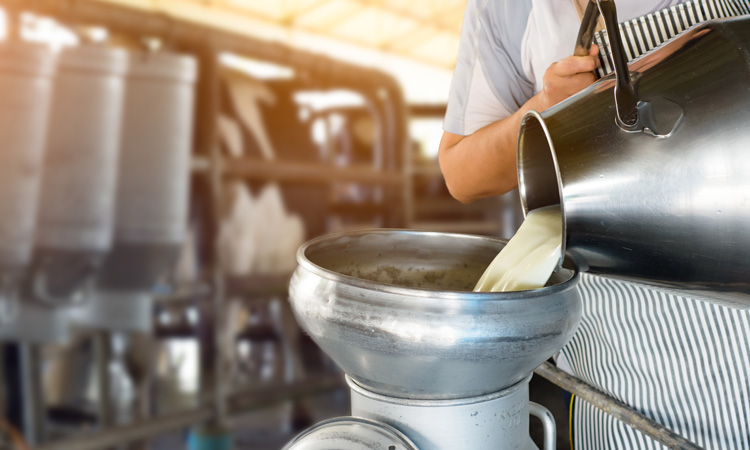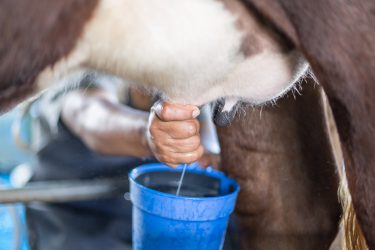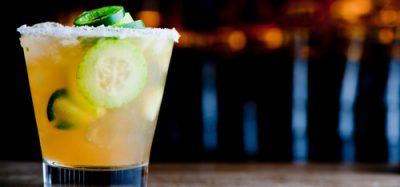The dairy industry – coming out the other side
- Like
- Digg
- Del
- Tumblr
- VKontakte
- Buffer
- Love This
- Odnoklassniki
- Meneame
- Blogger
- Amazon
- Yahoo Mail
- Gmail
- AOL
- Newsvine
- HackerNews
- Evernote
- MySpace
- Mail.ru
- Viadeo
- Line
- Comments
- Yummly
- SMS
- Viber
- Telegram
- Subscribe
- Skype
- Facebook Messenger
- Kakao
- LiveJournal
- Yammer
- Edgar
- Fintel
- Mix
- Instapaper
- Copy Link
Posted: 17 August 2020 | Carol Lever | No comments yet
Carol Lever, Director of the Free Range Dairy Network, discusses the present and future state of the dairy industry, highlighting how COVID-19 has and trade deals will impact the sector.


The reason we started Free Range Dairy Network and established the Pasture Promise logo is for shoppers and businesses to be able to make an informed decision when buying fresh milk. To be able to carry the Pasture Promise logo, the farmers must meet clear standards that are independently audited and one of the main requirements is the grazing standard. Cows must graze for 18 hours for 180 days and nights. A clear and easy opportunity for people to support traditional pasture based dairy farming and pay farmers a premium for their milk.
It is hard work in the dairy industry and no doubt it will continue to be very volatile. In 2018, the UK produced 15 billion litres of milk – the highest annual figure since 1990. This came after 2015 saw farmers protesting in supermarkets due to the low cost of milk being sold. The NFU said that the number of dairy farmers had halved in 10 years and in December 2014 alone another 60 left the business. But the number of cows remained relatively high, meaning that there was a move towards larger intensive farming to recoup lost revenue, chasing volume rather than the value of milk.
We hope that as people start to go back to their ‘normal’ lives as lockdown eases, they will remember how important supporting local food networks and farmers is for keeping fresh food on our tables.
However, despite this rollercoaster, milk remains a British staple, with 98 percent of UK households buying it. Volume sales have remained static over a five-year period, and per capita domestic purchasing has only declined by three litres per household over a three-year period.1
While plant-based milk alternatives continue to grow in popularity, they accounted for just four percent of volume sales and eight percent of value sales of white milk in 2018.2
Use of standard cow’s milk is sliding among 16-24-year-old consumers in Britain, falling from 79 percent in 2018 to 73 percent in 2019. While cow’s milk still accounted for most white milk sales in 2018 (96 percent), usage of this family favourite is increasingly skewed towards older consumers, peaking at 92 percent among over-45s, Mintel research suggests.
This fall in usage among 16-24s comes as 37 percent of this age group say they have reduced how much standard cow’s milk they have used in the last 12 months for health reasons, although milk is a powerhouse of nutrients. Environmental concerns are also playing a role, with 16-24s most likely (36 percent) to agree that dairy farming has a negative impact on the environment.
It is interesting that during the pandemic we have seen CO2 fall, and some cities have seen NO2 levels fall by up to 60 percent compared to the previous year. The air has been cleaner due to a reduced number of cars, planes, and other modes of transport, highlighting that perhaps the dairy industry’s carbon footprint is not as bad as some once thought.
COVID-19 and dairy
The COVID-19 lockdown resulted in significant supply chain disruption for dairy farms. Severely reduced demand from the hospitality industry as well as offices, meant some farmers were unable to sell their milk and as processors did not want to spend money on picking up and processing the milk, farmers had no option but to throw it away.
A difficult time for farmers as farm-gate prices dropped (although they have since recovered somewhat) and less markets available for their milk. The National Farmers Union estimated in early April 2020 that at least 2,000 dairy farmers were in financial difficulty. Moreover, the Agriculture and Horticulture Development Board (AHDB) said on 29 April that more than 5,200 of the estimated 9,200 dairy farmers in Britain had experienced a milk price reduction in spring 2020, while nearly 500 had milk collections cancelled. It also reported that 500 had payments deferred, 2,200 were asked to reduce milk output, and 700 had the volume they are usually paid a full price for reduced.
We really need to be supporting local food networks, traditional, pasture based dairy farming and adding value to our fresh milk not just volume.
In an April PQ (parliamentary questions), Defra Minister Victoria Prentis stated that between five and 10 percent of milk produced is sold to the hospitality industry and that “the vast majority of dairy farmers continue to supply their contracts at the usual price”. She also said that dairy farms can apply for support available to all businesses, this would be through the Defra hardship scheme, and that the Government has “eased some elements of competition law” to benefit the dairy sector. According to the press statement accompanying this measure, this would enable the industry to “work together to address current market challenges, avoiding waste and maintaining productive capacity to meet future demand”.
Like other farmers and milk companies, we saw milk consumption drop due to offices, coffee shops and catering companies closing, but retail and sales at vending machines saw an increase. Suddenly the need for fresh milk brought new customers to Pasture Promise farmers. People were looking for safe ways to buy fresh milk and support their local farmers as well as discovering great tasting milk. We got lots of feedback about how much people loved the taste of free range milk. We hope that as people start to go back to their ‘normal’ lives as lockdown eases, they will remember how important supporting local food networks and farmers is for keeping fresh food on our tables.
Defra’s hardship scheme
To mitigate the loss of earning during the pandemic it was announced by Defra that farmers will be able to apply for the hardship fund from 18 June 2020, with a lump-sum payment of up to £10,000 payable as early as 6 July.


This is not the time for Defra to cut corners for dairy farmers. Farmers have their herds which produce a certain level of milk each day. You cannot turn off that milk ‘tap’, then a few months later ask for it to be turned on again, unless farmers have support in the interim. Coffee shops and offices will reopen, and that milk will be wanted once more.
We really need to be supporting local food networks, traditional, pasture based dairy farming and adding value to our fresh milk not just volume. If not, there is a danger that to replace the lost farmers, more large intensive dairy farms will spring up as we saw in the aftermath of 2015.
Trade deals
Brexit is a worry. In trade deals with USA and other countries, the UK Prime Minister, Boris Johnson, first said that animal welfare would be protected but now that assurance has been removed.
A leaked memo allegedly instructed ministers to have “no specific policy” in relation to animal welfare in relation to upcoming trade deals. If true, it means that cheap food produced to lower standards could flood the UK market, putting both farmers and food safety at risk. The recent launch of the UK’s Trade and Agriculture Commission by International Trade Secretary, Liz Truss, should hopefully avert this…but only time will tell.
This Commission was a result of more than one million signatures on the National Farmers’ Union of England and Wales (NFU) petition, among other industry protests, which asked for our Food Safety Standards to be protected in any future trade deals.
The pandemic showed how vulnerable our supply chains can be and how we should be strengthening our local food production to the highest welfare, food safety and nutrients standards, as well as what is best for the environment.
There is a danger that to replace the lost farmers, more large intensive dairy farms will spring up as we saw in the aftermath of 2015.
Countries limiting or banning food exports has triggered warnings from United Nations food agency leaders about possible disruptions to the global food supply amid the COVID-19 pandemic – potentially making critical staples, such as wheat and rice, more costly and harder to find. Of course, each Government wants to keep food for their own citizens but imagine how vulnerable this would leave the UK if it meant we lost our local food networks and smaller farmers due to trade deals that undermine our food production.
Before the pandemic one of the most senior (UK) government advisors, Dr Tim Leunig, had allegedly said that Britain does not need its farming or fishing industries, that the food sector was “not critically important” to the wider UK economy.3 But food is not just about commerce. It really is life or death for the UK if other countries withhold food imports to feed their own citizens. Where could that leave us in the next pandemic if we have a weakened rather than strengthened food and farming industry?
Making informed choices
The origin of COVID-19 is still being investigated, but the belief is that it is a zoonotic disease, (ie, it jumped from animal to human). Arguably, this happens more often in industrial farming than pasture-based, free range farming. To compete with low quality and cheaply produced food through the proposed trade deals, many more farmers could be driven to industrial type of food production, not only bringing to the market poorer quality food, but arguably the risk of another pandemic.
In 2009, an outbreak of “Q fever” from intensively reared goats in the Netherlands saw 2,000 people made sick and kill at least six people. Recently a team of Chinese researchers looked at influenza viruses found in intensively reared pigs from 2011 to 2018 and found a “G4” strain of H1N1 that has “all the essential hallmarks of a candidate pandemic virus”,
What is important to acknowledge is we are living in uncertain times but what we can see is that if the government gives away what we have worked for, in relation to animal welfare, food safety standards and farming production, it will be up to the shoppers to show the government what we want from our food by voting with their wallet. This is when honest labelling such as the Pasture Promise logo will become even more important for our future safety.
References
- Kantar Worldpanel, 52we, 4 Nov 2018
- Mintel 2019
- https://www.dailymail.co.uk/news/article…
About the author
Carol Lever started Free Range Dairy Network in 2014. Prior to this, she was a campaign manager at an animal welfare charity, working to combat the rise in intensive dairy farming in the UK. Since establishing the Network, she has become passionate about the industry, working with farmers and local British processors to ensure a steady supply of milk in the UK.
Related topics
COVID-19, Research & development, Supply chain, Trade & Economy









